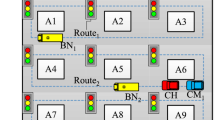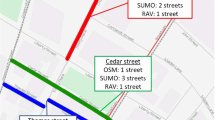Abstract
In large urban spaces, like cities, VANETs are formed by vehicles of highly variable speed and uneven geographic node distribution. Due to the ad-hoc nature of such environments, communication systems must seamlessly adapt to abrupt topology changes to keep the vehicular network organized. Maintain connectivity is hard; a possible naive strategy is based upon expensive on-demand reconnections. Another approach relies on controlled message epidemics. Both of them need to adjust communication behavior under different density situations. Thus, infrastructure-free density estimation methods are becoming popular solutions for this problem. Our paper contributes to this area using a unique density estimation method, independent of beaconing and neighbor discovery (which might generate network congestion), free of cooperative orchestration and based on long-term stability metrics. Our method is validated using vehicular mobility traces, showing outstanding group prediction and stability.
Access this chapter
Tax calculation will be finalised at checkout
Purchases are for personal use only
Similar content being viewed by others
Notes
- 1.
Because in pairwise connectivity two is the minimum number of points to form a group, so there will be no difference between core and border nodes (see [8]).
References
Aliyu, A., et al.: Cloud computing in VANETs: architecture, taxonomy, and challenges. IETE Tech. Rev. 35(5), 523–547 (2018)
Barrachina, J., et al.: I-VDE: a novel approach to estimate vehicular density by using vehicular networks. In: Cichoń, J., Gȩbala, M., Klonowski, M. (eds.) ADHOC-NOW 2013. LNCS, vol. 7960, pp. 63–74. Springer, Heidelberg (2013). https://doi.org/10.1007/978-3-642-39247-4_6
Bracciale, L., Bonola, M., Loreti, P., Bianchi, G., Amici, R., Rabuffi, A.: CRAWDAD dataset roma/taxi (v. 2014–07-17), July 2014. https://crawdad.org/roma/taxi/20140717
Chen, L., Bian, K.: Neighbor discovery in mobile sensing applications: a comprehensive survey. Ad Hoc Netw. 48, 38–52 (2016)
Chesterton, A.: How many cars are there in the world? (2018). https://www.carsguide.com.au/car-advice/how-many-cars-are-there-in-the-world-70629
Darwish, T., Bakar, K.A.: Traffic density estimation in vehicular ad hoc networks: a review. Ad Hoc Netw. 24, 337–351 (2015)
Doone, M.G., Cotton, S.L., Matolak, D.W., Oestges, C., Heaney, S.F., Scanlon, W.G.: Pedestrian-to-vehicle communications in an urban environment: channel measurements and modeling. IEEE Trans. Antennas Propag. 67(3), 1790–1803 (2018)
Ester, M., Kriegel, H.P., Sander, J., Xu, X.: A density-based algorithm for discovering clusters in large spatial databases with noise. In: International Conference on Knowledge Discovery and Data Mining, KDD 1996, pp. 226–231 (1996)
Grzybek, A., Seredynski, M., Danoy, G., Bouvry, P.: Detection of stable mobile communities in vehicular ad hoc networks. In: IEEE International Conference on Intelligent Transportation Systems (ITSC), pp. 1172–1178 (2014)
He, J., Cai, L., Pan, J., Cheng, P.: Delay analysis and routing for two-dimensional VANETs using carry-and-forward mechanism. IEEE Trans. Mobile Comput. 16(7), 1830–1841 (2017)
Jabbarpour, M.R., Noor, R.M., Khokhar, R.H., Ke, C.H.: Cross-layer congestion control model for urban vehicular environments. J. Netw. Comput. Appl. 44, 1–16 (2014)
Keränen, A., Kärkkäinen, T., Ott, J.: Simulating mobility and DTNs with the one. J. Commun. 5, 92–105 (2010)
Kim, T., Min, H., Choi, E., Jung, J.: Optimal job partitioning and allocation for vehicular cloud computing. Future Gener. Comput. Syst. 108, 82–96 (2020)
Kimura, T., Saito, H., Honda, H.: Optimal transmission range for v2i communications on congested highways. In: IEEE Annual International Symposium on Personal, Indoor, and Mobile Radio Communications (PIMRC), pp. 1–7 (2017)
Korn, A., Schubert, A., Telcs, A.: Lobby index in networks. Phys. A 388(11), 2221–2226 (2009)
Lakkakorpi, J., Pitkänen, M., Ott, J.: Adaptive routing in mobile opportunistic networks. In: 13th ACM International Conference on Modeling, Analysis, and Simulation of Wireless and Mobile Systems, MSWIM 2010, pp. 101–109. ACM (2010)
Liu, X.: A survey on clustering routing protocols in wireless sensor networks. Sensors 12(8), 11113–11153 (2012)
Pan, J., Cui, J., Wei, L., Xu, Y., Zhong, H.: Secure data sharing scheme for VANETs based on edge computing. EURASIP J. Wireless Comm. Netw. 2019 (2019)
Panichpapiboon, S., Pattara-atikom, W.: Exploiting wireless communication in vehicle density estimation. IEEE Trans. Veh. Technol. 60(6), 2742–2751 (2011)
Park, Y., Sur, C., Noh, S.W., Rhee, K.H.: Self-controllable secure location sharing for trajectory-based message delivery on cloud-assisted VANETs. Sensors 18(7), 2112 (2018)
Sun, Y., Luo, S., Dai, Q., Ji, Y.: An adaptive routing protocol based on QoS and vehicular density in urban VANETs. Int. J. Distrib. Sensor Netw. 2015, 5:5 (2015)
Toghi, B., Saifuddin, M., Mughal, M., Fallah, Y.P.: Spatio-temporal dynamics of cellular v2x communication in dense vehicular networks. In: IEEE Connected and Automated Vehicles Symposium (CAVS), pp. 1–5. IEEE (2019)
Vahdat, A., Becker, D.: Epidemic routing for partially-connected ad hoc networks. Technical report, Duke University (2000)
Vasilakos, A.V., Zhang, Y., Spyropoulos, T.: Delay Tolerant Networks: Protocols and Applications. Wireless Networks and Mobile Communications. CRC Press, Hoboken (2011)
Wang, J., Peeta, S., Lu, L., Li, T.: Multiclass information flow propagation control under vehicle-to-vehicle communication environments. Transp. Res. Part B Methodol. 129, 96–121 (2019)
Zeadally, S., Guerrero, J., Contreras, J.: A tutorial survey on vehicle-to-vehicle communications. Telecommun. Syst. 73(3), 469–489 (2019). https://doi.org/10.1007/s11235-019-00639-8
Acknowledgment
Authors thank Coord. de Aperfeiçoamento de Pessoal de Nível Superior - Brasil (CAPES) - Finance Code 001. H.S. also thanks Stic-AMSUD (project 20-STIC-09), and FAPESP (contracts 2018/22979-2 and 2015/24461-2) for their support.
Author information
Authors and Affiliations
Corresponding author
Editor information
Editors and Affiliations
Rights and permissions
Copyright information
© 2021 Springer Nature Switzerland AG
About this paper
Cite this paper
Costa, L.PP., Marcondes, C.A.C., Senger, H. (2021). Non-cooperative Vehicular Density Prediction in VANETs. In: Gervasi, O., et al. Computational Science and Its Applications – ICCSA 2021. ICCSA 2021. Lecture Notes in Computer Science(), vol 12952. Springer, Cham. https://doi.org/10.1007/978-3-030-86973-1_14
Download citation
DOI: https://doi.org/10.1007/978-3-030-86973-1_14
Published:
Publisher Name: Springer, Cham
Print ISBN: 978-3-030-86972-4
Online ISBN: 978-3-030-86973-1
eBook Packages: Computer ScienceComputer Science (R0)




